#stock landscape images
Text
New Stock Photo Workflow
I have taken advantage of a previously overlooked benefit of the Canon R7 to create a new stock photo workflow that will increase efficiency and upload volume.
The R7 of course comes with two card slots which can be configured to capture both raw and jpg images separately on card one and card two. Up to now I’ve been going through the arduous process of editing, rating and running just a few RAW…

View On WordPress
#books for sale#Colorado wall art#film photography#fuji film#landscape photography#landscape photography tips#model photography#model photography for stock#photography#photography books#photography techniques#photography tips#photography tips and tricks#prints#prints for sale#stock images#stock landscape images#stock photo licensing#stock photo tips#stock photography#tips and tricks#wall art#wildlife#wildlife photography books
1 note
·
View note
Photo
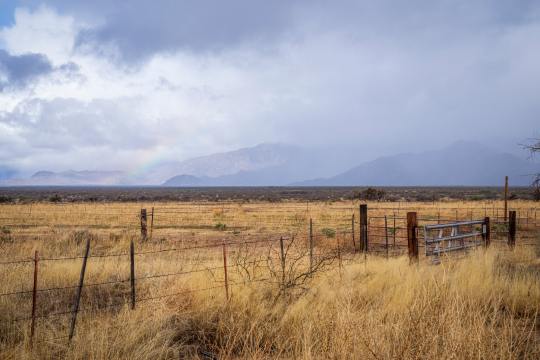
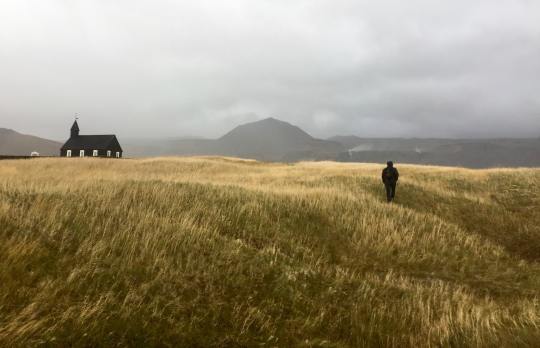
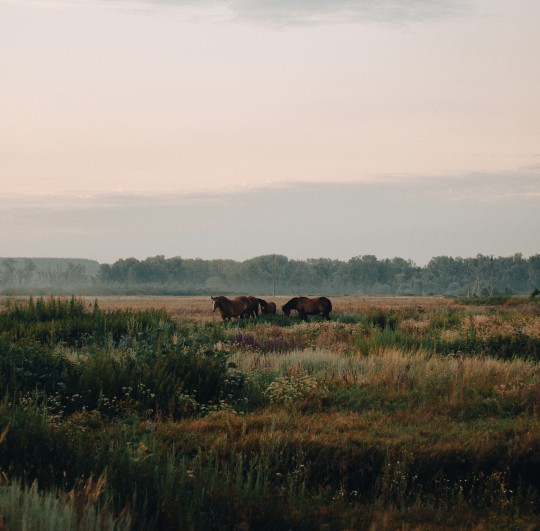
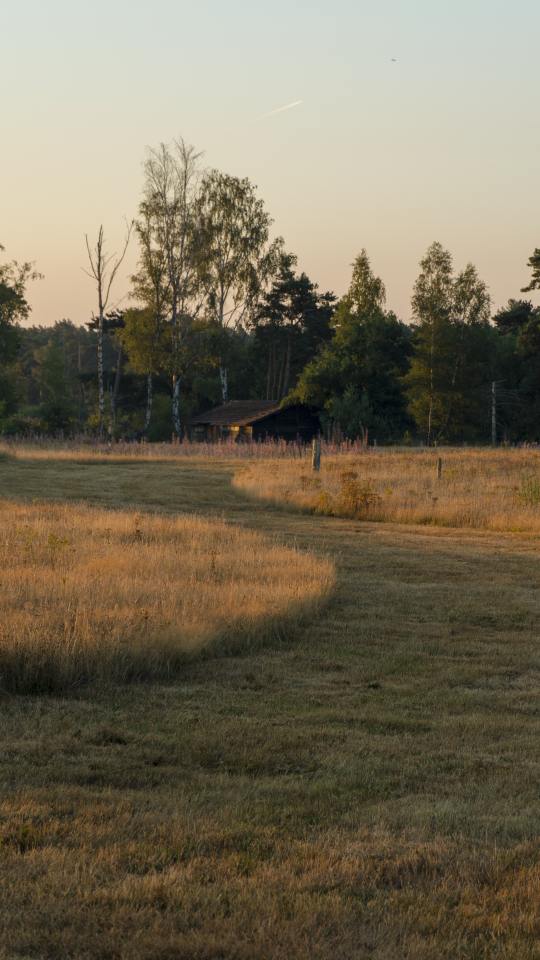
The wind sings through the grass and draws memories forgotten back home.
#all images free-to-use stock photos!#midwest gothic#fields#moodboard#horses#animals#nature#wanderlust#midwest#landscape#americana#american gothic#summer#fall#barns#churches
20 notes
·
View notes
Text
i am once again drawing something way above my capabilities
5 notes
·
View notes
Photo
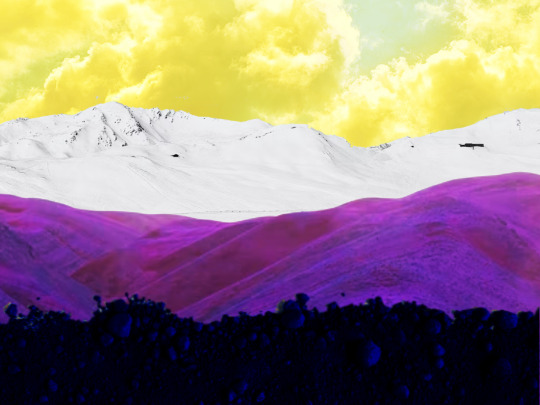

Non binary and trans flags made from stock photos
#Dreamcore#Dream Core#dream aesthetic#dreamcore aesthetic#pride#pride flags#trans flag#enby flag#nonbinary flag#trans#transgender#non binary#ice cream#landscape#stock images#stock photo edit#stock photo edits#photo edit#enby#pride month
10 notes
·
View notes
Text
hot artists don't gatekeep
I've been resource gathering for YEARS so now I am going to share my dragons hoard
Floorplanner. Design and furnish a house for you to use for having a consistent background in your comic or anything! Free, you need an account, easy to use, and you can save multiple houses.
Comparing Heights. Input the heights of characters to see what the different is between them. Great for keeping consistency. Free.
Magma. Draw online with friends in real time. Great for practice or hanging out. Free, paid plan available, account preferred.
Smithsonian Open Access. Loads of free images. Free.
SketchDaily. Lots of pose references, massive library, is set on a timer so you can practice quick figure drawing. Free.
SculptGL. A sculpting tool which I am yet to master, but you should be able to make whatever 3d object you like with it. free.
Pexels. Free stock images. And the search engine is actually pretty good at pulling up what you want.
Figurosity. Great pose references, diverse body types, lots of "how to draw" videos directly on the site, the models are 3d and you can rotate the angle, but you can't make custom poses or edit body proportions. Free, account option, paid plans available.
Line of Action. More drawing references, this one also has a focus on expressions, hands/feet, animals, landscapes. Free.
Animal Photo. You pose a 3d skull model and select an animal species, and they give you a bunch of photo references for that animal at that angle. Super handy. Free.
Height Weight Chart. You ever see an OC listed as having a certain weight but then they look Wildly different than the number suggests? Well here's a site to avoid that! It shows real people at different weights and heights to give you a better idea of what these abstract numbers all look like. Free to use.
188K notes
·
View notes
Text
I hope you enjoy this processed record of portions of the electromagnetic spectrum, from a single place and time, that were focused through a lens onto the recording device's sensor.
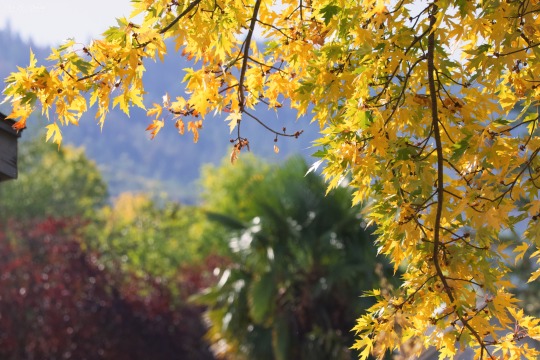
Photo by Xer S. Rowan, Creative Commons Attribution license
I take photos for the love of photography, and I share them under a free-to-use-as-long-as-I-am-properly-credited license. I'm disabled, neurodivergent, and living on a poverty-level fixed income. If you'd like to help me afford birdseed, want to see what I can do with a new lens, or otherwise desire to enrich my life a little, I have wishlists.
#creative commons photography#free stock images#original photography on tumblr#autumn photography#autumn leaves#autumn#fall leaves#fall vibes#maple leaves#maple tree#trees#landscaping#colorful#backyard photography#photography
0 notes
Text

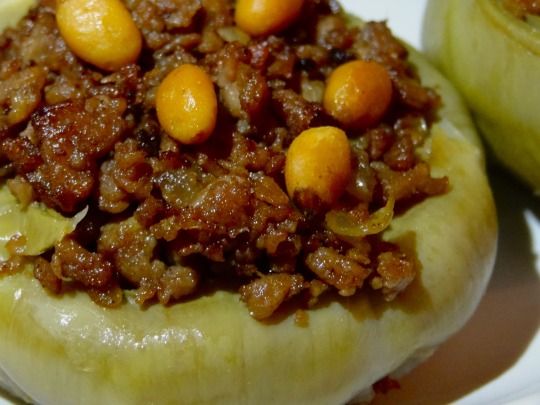
[ID: The first image is of four stuffed artichoke hearts on a plate with a mound of rice and fried vermicelli; the second is a close-up on one artichoke, showing fried ground 'beef' and golden pine nuts. End ID]
أرضي شوكي باللحم / Ardiyy-shawkiyy b-al-lahm (Stuffed artichoke hearts)
Artichoke hearts stuffed with spiced meat make a common dish throughout West Asia and North Africa, with variations on the recipe eaten in Lebanon, Syria, Palestine, Algeria, and Morocco. In Palestine, the dish is usually served on special occasions, either as an appetizer, or as a main course alongside rice. The artichokes are sometimes paired with cored potatoes, which are stuffed and cooked in the same manner. Stuffed artichokes do not appear in Medieval Arab cookbooks (though artichokes do), but the dish's distribution indicates that its origin may be Ottoman-era, as many other maḥshis (stuffed dishes) are.
The creation of this dish is easy enough once the artichoke hearts have been excavated (or, as the case may be, purchased frozen and thawed): they are briefly deep-fried, stuffed with ground meat and perhaps pine nuts, then stewed in water, or water and tomato purée, or stock, until incredibly tender.
While simple, the dish is flavorful and well-rounded. A squeeze of lemon complements the bright, subtle earthiness of the artichoke and cuts through the richness of the meat; the fried pine nuts provide a play of textures, and pick up on the slight nutty taste that artichokes are known for.
Terminology and etymology
Artichokes prepared in this way may be called "ardiyy-shawkiyy b-al-lahm." "Ardiyy-shawkiyy" of course means "artichoke"; "ب" ("b") means "with"; "ال" ("al") is the determiner "the"; and "لَحْم" ("laḥm") is "meat" (via a process of semantic narrowing from Proto-Semitic *laḥm, "food"). Other Palestinian Arabic names for the same dish include "أرضي شوكي محشي" ("ardiyy-shawkiyy maḥshi," "stuffed artichokes"), and "أرضي شوكي على ادامه" ("ardiyy-shawkiyy 'ala adama," "artichokes cooked in their own juice").
The etymology of the Levantine dialectical phrase meaning "artichoke" is interestingly circular. The English "artichoke" is itself ultimately from Arabic "الخُرْشُوف" ("al-khurshūf"); it was borrowed into Spanish (as "alcarchofa") during the Islamic conquest of the Iberian peninsula, and thence into English via the northern Italian "articiocco." The English form was probably influenced by the word "choke" via a process of phono-semantic matching—a type of borrowing wherein native words are found that sound similar to the foreign word ("phonetics"), and communicate qualities associated with the object ("semantics").
"Artichoke" then returned to Levantine Arabic, undergoing another process of phono-semantic matching to become "ardiyy-shawkiyy": أَرْضِيّ ("ʔarḍiyy") "earthly," from أَرْض ("ʔarḍ"), "Earth, land"; and شَوْكِيّ ("shawkiyy") "prickly," from شَوْك ("shawk"), "thorn."
Artichokes in Palestine
Artichoke is considered to be very healthful by Palestinian cooks, and it is recommended to also consume the water it is boiled in (which becomes delightfully savory and earthy, suitable as a broth for soup). In addition to being stuffed, the hearts may be chopped and cooked with meat or potatoes into a rich soup. These soups are enjoyed especially during Ramadan, when hot soup is popular regardless of the season—but the best season for artichokes in the Levant is definitively spring. Stuffed artichokes are thus often served by Jewish people in North Africa and West Asia during Passover.
Artichokes grow wild in Palestine, sometimes in fields adjacent to cultivated crops such as cereals and olives. Swiss traveler Johann Ludwig Burckhardt, writing in 1822, referred to the abundant wild artichoke plants (presumably Cynara syriaca) near لُوبْيا ("lūbyā"), a large village of stone buildings on a hilly landscape just west of طبريا ("ṭabariyya," Tiberias):
About half an hour to the N. E. [of Kefer Sebt (كفر سبط)] is the spring Ain Dhamy (عين ظامي), in a deep valley, from hence a wide plain extends to the foot of Djebel Tor; in crossing it, we saw on our right, about three quarters of an hour from the road, the village Louby (لوبي), and a little further on, the village Shedjare (شجره). The plain was covered with the wild artichoke, called khob (خُب); it bears a thorny violet coloured flower, in the shape of an artichoke, upon a stem five feet in height.
(Despite resistance from local militia and the Arab Liberation Army, Zionist military groups ethnically cleansed Lubya of its nearly 3,000 Palestinian Arab inhabitants in July of 1948, before reducing its buildings and wells to rubble, The Jewish National Fund later planted the Lavi pine forest over the ruins.)
Artichokes are also cultivated and marketed. Elihu Grant, nearly a century after Burckhardt's writing, noted that Palestinian villages with sufficient irrigation "[went] into gardening extensively," and marketed their goods in crop-poor villages or in city markets:
Squash, pumpkin, cabbage, cauliflower, lettuce, turnip, beet, parsnip, bean, pea, chick-pea, onion, garlic, leek, radish, mallow and eggplant are common varieties [of vegetable]. The buds of the artichoke when boiled make a delicious dish. Potatoes are getting to be quite common now. Most of them are still imported, but probably more and more success will be met in raising a native crop.
Either wild artichokes (C. syriaca) or cardoons (C. cardunculus, later domesticated to yield modern commerical artichokes) were being harvested and eaten by Jewish Palestinians in the 1st to the 3rd centuries AD (the Meshnaic Hebrew is "עַכָּבִיּוֹת", sg. "עַכָּבִית", "'aqubit"; related to the Arabic "عَكُوب" "'akūb," which refers to a different plant). The Tosefta Shebiit discusses how farmers should treat the sprouting of artichokes ("קינרסי," "qinrasi") during the shmita year (when fields are allowed to lie fallow), indicating that Jews were also cultivating artichokes at this time.
Though artichokes were persistently associated with wealth and the feast table (perhaps, Susan Weingarten speculates, because of the time they took to prepare), trimming cardoons and artichokes during festivals, when other work was prohibited, was within the reach of common Jewish people. Those in the "upper echelons of Palestinian Jewish society," on the other hand, had access to artichokes year-round, including (through expensive marvels of preservation and transport) when they were out of season.
Jewish life and cuisine
Claudia Roden writes that stuffed artichoke, which she refers to as "Kharshouf Mahshi" (خرشوف محشي), is "famous as one of the grand old Jerusalem dishes" among Palestinian Jews. According to her, the stuffed artichokes used to be dipped in egg and then bread crumbs and deep-fried. This breading and frying is still referenced, though eschewed, in modern Sephardi recipes.
Prior to the beginning of the first Aliyah (עלייה, wave of immigration) in 1881, an estimated 3% of the overall population of Palestine, or 15,011 people, were Jewish. This Jewish presence was not the result of political Zionist settler-colonialism of the kind facilitated by Britain and Zionist organizations; rather, it consisted of ancestrally Palestinian Jewish groups, and of refugees and religious immigrants who had been naturalized over the preceding decades or centuries.
One such Jewish community were the Arabic-speaking Jews whom the Sephardim later came to call "מוּסְתערבים" or "مستعربين" ("Musta'ravim" or "Musta'ribīn"; from the Arabic "مُسْتَعْرِب" "musta'rib," "Arabized"), because they seemed indifferentiable from their Muslim neighbors. A small number of them were descendants of Jews from Galilee, which had had a significant Jewish population in the mid-1st century BC; others were "מגרבים" ("Maghrebim"), or "مغربية" ("Mughariba"): descendents of Jews from Northwest Africa.
Another major Jewish community in pre-mandate Palestine were Ladino-speaking descendents of Sephardi Jews, who had migrated to Palestine in the decades following their expulsion from Spain and then Portugal in the late 15th century. Though initially seen as foreign by the 'indigenous' Mista'avim, this community became dominant in terms of population and political influence, coming to define themselves as Ottoman subjects and as the representatives of Jews in Palestine.
A third, Yiddish- and German-speaking, Askenazi Jewish population also existed in Palestine, the result of immigration over the preceding centuries (including a large wave in 1700).
These various groups of Jewish Palestinians lived as neighbors in urban centers, differentiating themselves from each other partly by the language they spoke and partly by their dress (though Sephardim and Ashkenazim quickly learned Arabic, and many Askenazim and Muslims learned Ladino). Ashkenazi women also learned from Sephardim how to prepare their dishes. These groups' interfamiliarity with each other's cuisine is further evidenced by the fact that Arabic words for Palestinian dishes entered Ladino and Yiddish (e.g. "كُفْتَة" / "kufta," rissole; "مَزَّة" "mazza," appetizer); and words entered Arabic from Ladino (e.g. "דונסי" "donsi," sweet jams and fruit leather; "בוריק" "burek," meat and cheese pastries; "המים" "hamim," from "haminados," braised eggs) and Yiddish (e.g. "לעקעך" "lakach," honey cake).
In addition to these 'native' Jews were another two waves of Ashkenazi migration in the late 18th and early-to-mid 19th centuries (sometimes called the "היישוב הישן," "ha-yishuv ha-yashan," "old settlement," though the term is often used more broadly); and throughout the previous centuries there had also been a steady trickle of religious immigration, including elderly immigrants who wished to die in Jerusalem in order to be present at the appointed place on the day of Resurrection. Recent elderly women immigrants unable to receive help from charitable institutions would rely on the community for support, in exchange helping the young married women of the neighborhood with childcare and with the shaping of pastries ("מיני מאפה").
In the first few centuries AD, the Jewish population of Palestine were largely farmers and agricultural workers in rural areas. By the 16th century, however, most of the Jewish population resided in the Jewish Holy Cities of Jerusalem (القُدس / al-quds), Hebron (الخليل / al-khalil), Safed (صفد), and Tiberias (طبريا / ṭabariyya). In the 19th century, the Jewish population lived entirely in these four cities and in expanding urban centers Jaffa and Haifa, alongside Muslims and Christians. Jerusalem in particular was majority Jewish by 1880.
In the 19th century, Jewish women in Jerusalem, like their Christian and Muslim neighbors, used communal ovens to bake the bread, cakes, matzah, cholent, and challah which they prepared at home. One woman recalls that bread would be sent to the baker on Mondays and Thursdays—but bribes could be offered in exchange for fresh bread on Shabbat. Charges would be by the item, or else a fixed monthly payment.
Trips to the ovens became social events, as women of various ages—while watching the bakers, who might not put a dish in or take it out in time—sent up a "clatter" of talking. During religious feast days, with women busy in the kitchen, some families might send young boys in their stead.
Markets and bakeries in Jerusalem sold bread of different 'grades' based on the proportion of white and wheat flour they contained; as well as flatbread (خبز مفرود / חובז מפרוד / khobbiz mafroud), Moroccan מאווי' / ماوي / meloui, and semolina breads (כומאש / كماج / kmaj) which Maghrebim especially purchased for the Sabbath.
On the Sabbath, those who had brick ovens in their sculleries would keep food, and water for tea and coffee, warm from the day before (since religious law prohibits performing work, including lighting fires, on Shabbat); those who did not would bring their food to the oven of a neighbor who did.
Palestinian Jewish men worked in a variety of professions: they were goldsmiths, writers, doctors, merchants, scientists, linguists, carpenters, and religious scholars. Jewish women, ignoring prohibitions, engaged in business, bringing baked goods and extra dairy to markets in Jerusalem, grinding and selling flour, spinning yarn, and making clothing (usually from materials purchased from Muslims); they were also shopkeepers and sellers of souvenirs and wine. Muslims, Jews, and Christians shared residential courtyards, pastimes, commercial enterprises, and even holidays and other religious practices.
Zionism and Jewish Palestinians
Eastern European Zionists in the 1880s and 90s were ambivalent towards existing Jewish communities in Palestine, often viewing them as overly traditional and religious, backwards-thinking, and lacking initiative. Jewish Palestinians did not seem to conform with the land-based, agricultural, and productivist ideals of political Zionist thinkers; they were integrated into the Palestinian economy (rather than seeking to create their own, segregated one); they were not working to create a Jewish ethnostate in Palestine, and seemed largely uninterested in nationalist concerns. Thus they were identified with Diaspora Jewish culture, which was seen as a remnant of exile and oppression to be eschewed, reformed, or overthrown.
These attitudes were applied especially to Sephardim and Mista'arevim, who were frequently denigrated in early Zionist literature. In 1926, Revisionist Zionist leader Vladimir Jabotinsky wrote that the "Jews, thank God, have nothing in common with the East. We must put an end to any trace of the Oriental spirit in the Jews of Palestine." The governance of Jewish communities was, indeed, changed with the advent of the British Mandate (colonial rule which allowed the British to facilitate political Zionist settling), as European political and "socialist" Zionists promoted Ashkenazi over Sephardi leadership.
Under the Ottomans, the millet system had allowed a degree of Jewish and Christian autonomy in matters of religious study and leadership, cultural and legal affairs, and the minting of currency. The religious authority of all Jewish people in Palestine had been the Sephardi Rabbi of Jerusalem, and his authority on matters of Jewish law (like the authority of the Armenian Patriarchate on matters of Christian law) extended outside of Palestine.
But British and European funding allowed newer waves of Ashkenazi settlers (sometimes called "היישוב החדש," "ha-yishuv ha-khadash," "new settlement")—who, at least if they were to live out the ideals of their sponsors, were more secular and nationalist-minded than the prior waves of Ashkenazi immigration—to be de facto independent of Sephardi governance. Several factors lead to the drying up of halaka (donated funds intended to be used for communal works and the support of the poor in Sephardi communities), which harmed Sephardim economically.
Zionist ideas continued to dominate newly formed committees and programs, and Palestinian and Sephardi Jews reported experiences of racial discrimination, including job discrimination, leading to widespread poverty. The "Hebrew labor" movement, which promoted a boycott of Palestinian labor and produce, in fact marginalized all workers racialized as Arab, and promises of work in Jewish labor unions were divided in favor of Ashkenazim to the detriment of Sephardim and Mizrahim. This economic marginalization coincided with the "social elimination of shared indigenous [Palestinian] life" in the Zionist approach to indigenous Jews and Muslims.
Despite the adversarial, disdainful, and sometimes abusive relationship which the European Zionist movement had with "Oriental" Jews, their presence is frequently used in Zionist food and travel writing to present Israel as a multicultural and pluralist state. Dishes such as stuffed artichokes are claimed as "Israeli"—though they were eaten by Jews in Palestine prior to the existence of the modern state of Israel, and though Sephardi and Mizrahi diets were once the target of a civilizing, correcting mission by Zionist nutritionists. The deep-frying that stuffed artichokes call for brings to mind European Zionists' half-fascinated, half-disgusted attitudes towards falafel.
The point is not to claim a dish for any one national or ethnic group—which is, more often than not, an exercise in futility and even absurdity—but to pay attention to how the rhetoric of food writing can obscure political realities and promote the colonizer's version of history. The sinking of Jewish Palestinian life prior to the advent of modern political Zionism, and the corresponding insistence that it was Israel that brought "Jewish cuisine" to Palestine, allow for such false dichotomies as "Jewish-Palestinian relations" or "Jewish-Arab relations"; these descriptors further Zionist rhetoric by making a clear situation of ethnic cleansing and settler-colonialism sound like a complex and delicate issue of inter-ethnic conflict. To boot, the presentation of these communities as having merely paved the way to Zionist nationalism ignores their existence as groups with their own political, social, and cultural lives and histories.
Help evacuate a Gazan family with Operation Olive Branch
Buy an eSim for use in Gaza
Help Anera provide food in Gaza
Ingredients:
Serves 4 (as a main dish).
For the artichokes:
6 fresh, very large artichokes; or frozen (not canned) whole artichoke hearts
1 lemon, quartered (if using fresh artichokes)
250g (1 1/2 cups) vegetarian ground beef substitute; or 3/4 cup TVP hydrated with 3/4 cup vegetarian 'beef' stock from concentrate
1 yellow onion, minced
Scant 1/2 tsp kosher salt
1/2 tsp ground black pepper
1 pinch ground cardamom (optional)
1/4 tsp ground allspice or seb'a baharat (optional)
1 Tbsp pine nuts (optional)
Water, to simmer
Oil, to fry
2 tsp vegetarian 'beef' stock concentrate, to simmer (optional)
Lemon, to serve
Larger artichokes are best, to yield hearts 3-4 inches in width once all leaves are removed. If you only have access to smaller artichokes, you may need to use 10-12 to use up all the filling; you might also consider leaving some of the edible internal leaves on.
The meat may be spiced to taste. Sometimes only salt and black pepper are used; some Palestinian cooks prefer to include seb'a baharat, white pepper, allspice, nutmeg, cardamom, and/or cinnamon.
Medieval Arab cookbooks sometimes call for vegetables to be deep-fried in olive oil (see Fiḍālat al-Khiwān fī Ṭayyibāt al-Ṭaʿām wa-l-Alwān, chapter 6, recipe no. 373, which instructs the reader to treat artichoke hearts this way). You may use olive oil, or a neutral oil such as canola or sunflower (as is more commonly done in Palestine today).
Elihu Grant noted in 1921 that lemon juice was often served with stuffed vegetable dishes; today stuffed artichokes are sometimes served with lemon.
For the rice:
200g Egyptian rice (or substitute any medium-grained white rice)
2 tsp broken semolina vermicelli (شعيريه) (optional)
1 tsp olive oil (optional)
Large pinch salt
520g water, or as needed
Broken semolina vermicelli (not rice vermicelli!) can be found in plastic bags at halal grocery stores.
Instructions:
For the stuffed artichokes:
1. Prepare the artichoke hearts. Cut off about 2/3 of the top of the artichoke (I find that leaving at least some of the stem on for now makes it easier to hollow out the base of the artichoke heart without puncturing it).
2. Pull or cut away the tough outer bracts ("leaves") of the artichoke until you get to the tender inner leaves, which will appear light yellow all the way through. As you work, rub a lemon quarter over the sides of the artichoke to prevent browning.
3. If you see a sharp indentation an inch or so above the base of the artichoke, use kitchen shears or a sharp knife to trim off the leaves above it and form the desired bowl shape. Set aside trimmings for a soup or stew.
4. Use a small spoon to remove the purple leaves and fibers from the center of the artichoke. Make sure to scrape the spoon all along the bottom and sides of the artichoke and get all of the fibrous material out.
5. Use a paring knife to remove any remaining tough bases of removed bracts and smooth out the base of the artichoke heart. Cut off the entire stem, so that the heart can sit flat, like a bowl.
6. Place the prepared artichoke heart in a large bowl of water with some lemon juice squeezed into it. Repeat with each artichoke.
7. Drain artichoke hearts and pat dry. Heat a few inches of oil in a pot or wok on medium and fry artichoke hearts, turning over occasionally, for a couple minutes until lightly browned. If you don't want to deep-fry, you can pan-fry in 1 cm or so of oil, flipping once. Remove with a slotted spoon and drain.
8. Prepare the filling. Heat 1 tsp of olive oil in a large skillet on medium-high and fry onions, agitating often, until translucent.
Tip: Some people add the pine nuts and brown them at this point, to save a step later. If you do this, they will of course be mixed throughout the filling rather than being a garnish on top.
9. Add spices, salt, and meat substitute and fry, stirring occasionally, until meat is browned. (If using TVP, brown it by allowing it to sit in a single layer undisturbed for 3-4 minutes, then stir and repeat.) Taste and adjust spices and salt.
10. Heat 1 Tbsp of olive oil or margarine in a small pan on medium-low. Add pine nuts and fry, stirring constantly, until they are a light golden brown, then remove with a slotted spoon. Note that, once they start taking on color, they will brown very quickly and must be carefully watched. They will continue to darken after they are removed from the oil, so remove them when they are a shade lighter than desired.
11. Stuff the artichoke hearts. Fill the bowl of each heart with meat filling, pressing into the bottom and sides to fill completely. Top with fried pine nuts.
12. Cook the artichoke hearts. Place the stuffed artichoke hearts in a single layer at the bottom of a large stock pot, along with any extra filling (or save extra filling to stuff peppers, eggplant, zucchini, or grape leaves).
13. Whisk stock concentrate into several cups of just-boiled water, if using—if not, whisk in about a half teaspoon of salt. Pour hot salted water or stock into the pot to cover just the bottoms of the stuffed artichokes.
14. Simmer, covered, for 15-20 minutes, until the artichokes are tender. Simmer uncovered for another 5-10 minutes to thicken the sauce.
For the rice:
1. Rinse your rice once by placing it in a sieve, putting the sieve in a closely fitting bowl, then filling the bowl with water; rub the rice between your fingers to wash, and remove the sieve from the bowl to strain.
2. Place a bowl on a kitchen scale and tare. Add the rice, then add water until the total weight is 520g. (This will account for the amount of water stuck to the rice from rinsing.)
3. (Optional.) In a small pot with a close-fitting lid, heat 1 tsp olive oil. Add broken vermicelli and fry, agitating often, until golden brown.
4. Add the rice and water to the pot and stir. Increase heat to high and allow water to come to a boil. Cover the pot and lower heat to a simmer. Cook the rice for 15 minutes. Remove from heat and steam for 10 minutes.
To serve:
1. Plate artichoke hearts on a serving plate alongside rice and lemon wedges; or, place artichoke hearts in a shallow serving dish, pour some of their cooking water in the base of the dish, and serve rice on a separate plate.
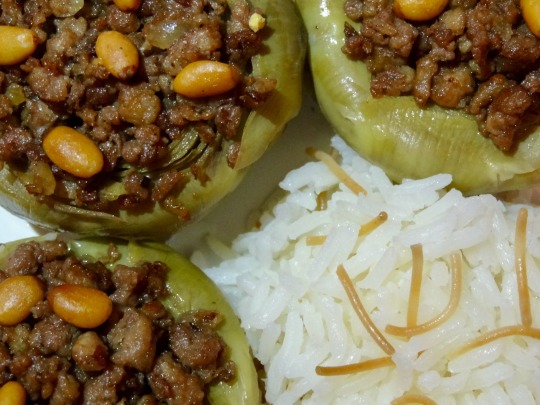
Tip: The white flesh at the base of the bracts (or "leaves") that you removed from the artichokes for this recipe is also edible. Try simmering removed leaves in water, salt, and a squeeze of lemon for 15 minutes, then scraping the bract between your teeth to eat the flesh.
182 notes
·
View notes
Text
The art of Daniel Danger
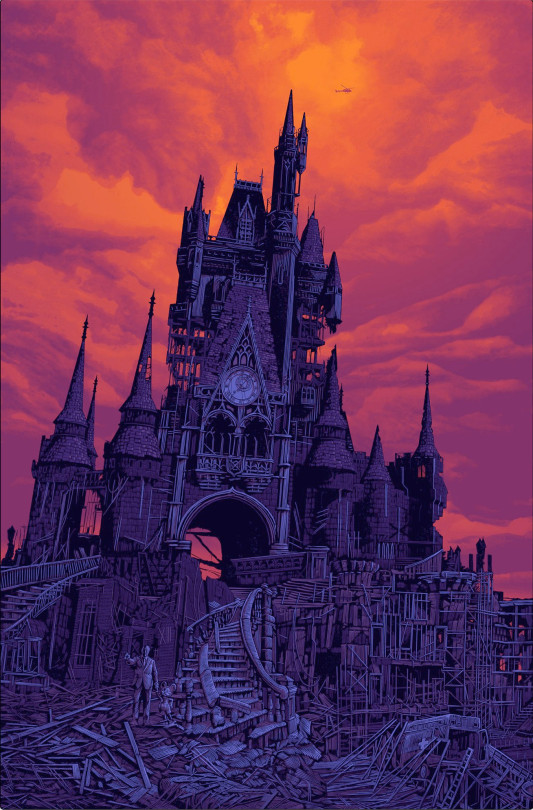
[Image ID: Daniel Danger's art print, 'To all who home to this happy place,' depicting a ruined Disneyland castle in a post-apocalyptic landscape with a statue of Walt and Mickey in the rubble.]
There’s this behavioral economics study that completely changed the way i thought about art, teaching, and critique: it’s a 1993 study called “Introspecting about Reasons can Reduce Post-Choice Satisfaction” by Timothy D Wilson, Douglas J Lisle, Jonathan Schooler, Sara Hodges, Kristen Klaaren and Suzanne LaFleur:
https://www.researchgate.net/publication/240281868_Introspecting_about_Reasons_can_Reduce_Post-Choice_Satisfaction
The experimenters asked subjects to preference-rank some art posters; half the posters were cute cartoony posters, and the other half were fine art posters. One group of subjects assigned a simple numeric rank to the posters, and the other had to rank them and explain their ranking. Once they were done, they got to keep their posters.
There was a stark difference in the two groups’ preferences: the group that had to explain their choices picked the cartoony images, while the group that basically got to point at their favorite and say, “Ooh, I like that!” chose the fine art posters.
Then, months later, the experimenters followed up and asked the subjects what they’d done with the poster they got to take home. The ones who’d had to explain their choices and had brought home cartoony images had thrown those posters away. The ones who didn’t have to explain what they liked about their choice, who’d chosen fine art, had hung them up at home and kept them there.
The implication is that it’s hard to explain what makes art good, and the better art is, the harder it is to put your finger on what makes it so good. More: the obvious, easy-to-articulate virtues of art are the less important virtues. Art’s virtues are easy to spot and hard to explain.
The reason this stuck with me is that I learned to be a writer through writing workshops where we would go around in a circle and explain what we liked and didn’t like about someone’s story, and suggest ways to make it better. I started as a teenager in workshops organized by Judith Merril in Toronto, then through my high-school workshop (which Judy had actually founded a decade-plus earlier through a writer in the schools grant), and then at the Clarion workshop in 1992. I went on to teach many of these workshops: Clarion, Clarion West and Viable Paradise.
So I’ve spent a lot of time trying to explain what was and wasn’t good about other peoples’ art (and my own!), and how to make it better. There’s a kind of checklist to help with this: when a story is falling short in some way, writers roll out these “rules” for what makes for good and bad prose. There are a bunch of these rulesets (think of Strunk & White’s Elements of Style), including some genre-specific ones like the Turkey City Lexicon:
https://www.sfwa.org/2009/06/18/turkey-city-lexicon-a-primer-for-sf-workshops/
A few years ago, I was teaching on the Writing Excuses cruise and a student said something like, “Hey, I know all these rules for writing good stories, but I keep reading these stories I really like and they break the rules. When can I break the rules?”
There’s a stock answer a writing teacher is supposed to give here: “Well, first you have to master the rules, then you can break them. You can’t improvise a jazz solo without first learning your scales.”
But in that moment, I thought back to the study with the posters and I had a revelation. These weren’t “rules” at all — they were just things that are hard and therefore easy to screw up. No one really knows why a story isn’t working, but they absolutely know when it doesn’t, and so, like the experimental subject called upon to explain their preferences, they reach for simple answers: “there’s too much exposition,” or “you don’t foreshadow the ending enough.”
There are lots of amazing stories that are full of exposition (readers of mine will not be shocked to learn I hold this view). There are lots of twist endings that are incredible — and not despite coming out of left field, but because of it.
The thing is, if you can’t say what’s wrong, but you know something is wrong, it’s perfectly reasonable to say, “Well, why don’t you try to replace or polish the things that are hardest to do right. Whatever it is that isn’t working here, chances are it’s the thing that’s hardest to make work”:
https://locusmag.com/2020/05/cory-doctorow-rules-for-writers/
But if I could change one thing about how we talk about writing and its “rules,” it would be to draw this distinction, characterizing certain literary feats as easier to screw up than others, having the humility to admit that we just don’t know what’s wrong with a story, and then helping the writer create probabilistically ranked lists of the things they could tinker with to try and improve their execution.
Which is all a very, very long-winded way to explain why I bought a giant, gorgeous art-print at Comic-Con this weekend, even though I have nowhere to hang it and had sworn I would absolutely not buy any art at the con.
I was walking the floor, peeking into booths, when I happened on Daniel Danger’s booth (#5034, if you’re at the con today), and I was just fuckin’ poleaxed by his work.
http://www.tinymediaempire.com/

[Image ID: Daniel Danger’s ‘It stopped being about the panic,’ depicting a ruined mansion interwoven with the skeletal branches of a tree, with a weeping statue and two human figures]
Now, see above. I can’t tell you why I loved this work so much (and that’s OK!), but boy oh boy did it speak to me. I just kind of stood there with my mouth open, slowly moving from print to print, admiring works like “It stopped being about the panic.”
https://tinymediaempire.myshopify.com/products/2022-sdcc-it-stopped-being-about-the-panic-v4
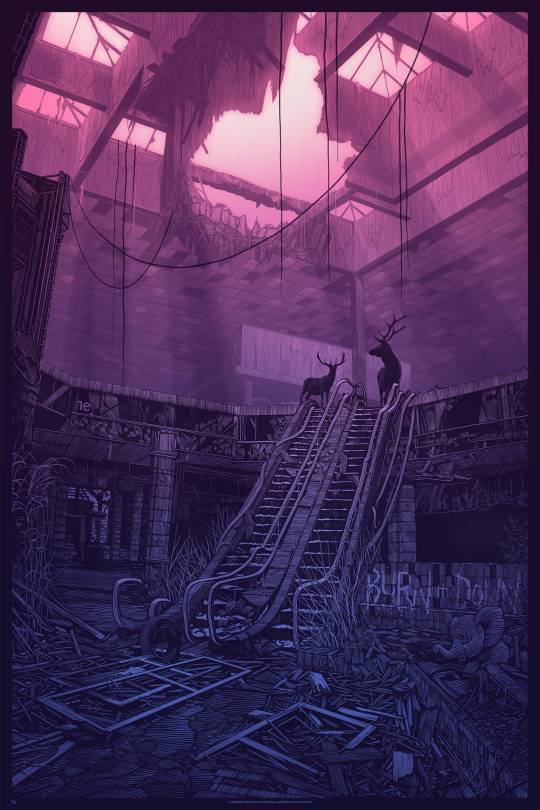
[Image ID: Daniel Danger’s ‘headlight in the path of,’ depicting a ruined mall with a pair of stags standing at the top of the escalator.]
On the surface, this is moody, post-apocalyptic stuff, heavily influenced by classic monster/haunter tropes, but it’s shot through with hope and renewal and the sense of something beautiful growing out of the ashes of something that has toppled. There’s real “(Nothing But) Flowers” energy in “Headlight in the path of”:
https://tinymediaempire.myshopify.com/products/sdcc2023-headlight-in-the-path-of-v2
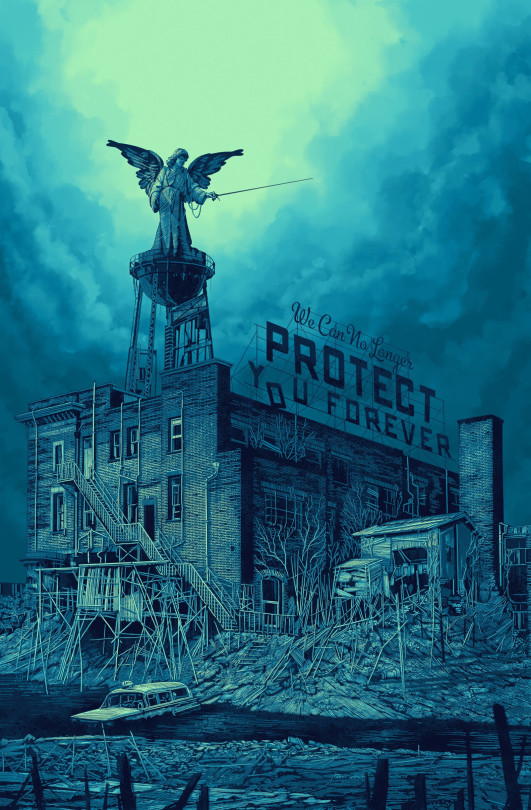
[Image ID: Daniel Danger’s ‘We are no longer able to protect you,’ depicting a ruined factory with a coming-apart sign reading ‘We can no longer protect you forever,’ and a statue of a sword-bearing angel.]
Danger isn’t just a
very
talented artist, he’s also an
extremely
talented craftsman. As a recovering pre-press geek, I was (nearly) as impressed by the wild use of spot color and foils as I was by the art, like in “We are no longer able to protect you”:
https://tinymediaempire.myshopify.com/products/sdcc-2022-we-can-no-longer-protect-you-forever-v3

[Image ID: Daniel Danger’s ‘made of smoke and chains,’ depicting a ruined landscape with a pair of derelict subway trains at the foot of a hill on whose peak is a rotting mansion. A pair of human figures, holding hands, are approaching the mansion.]
Danger himself calls this work “weird sad hyper-detailed artwork of dreamy buildings of ghosts and trees,” which is a very apt description of this work, as you can see in “Made of smoke and chains”:
https://tinymediaempire.myshopify.com/products/made-of-smoke-and-chains-mist-preorder
So I looked at this stuff and sternly reminded myself that there was no way I was going to buy any art at the con. Then I walked away. I got about two aisles over when I realized I had to go back and ask permission to take some pictures so I could put a little link to Danger in my blog’s linkdump, which he graciously permitted:
https://www.flickr.com/search/?sort=interestingness-desc&safe_search=1&tags=danieldanger&min_taken_date=1687478400&max_taken_date=1690156799&view_all=1

[Image ID: Daniel Danger’s art print, ‘To all who home to this happy place,’ depicting a ruined Disneyland castle in a post-apocalyptic landscape with a statue of Walt and Mickey in the rubble.]
But then I got all the way ass over to the other ass end of the convention center and I realized I had to go back and buy one of these prints. Which I did, “To all who come to this happy place,” because fuckin’ wow:
https://tinymediaempire.myshopify.com/products/sdcc2023-this-happy-place-v6-foil
This was unequivocally the best thing I saw at this year’s SDCC, but I also got some very good news while there, namely, that Emil Ferris’s long, long-awaited My Favorite Thing Is Monsters Vol 2 is finally on the schedule from Fantagraphics:
https://www.fantagraphics.com/collections/emil-ferris/products/my-favorite-thing-is-monsters-book-two
It’s coming out in April, which gives you plenty of time to read volume one, which I called, “a haunting diary of a young girl as a dazzling graphic novel”:
https://memex.craphound.com/2017/06/20/my-favorite-thing-is-monsters-a-haunting-diary-of-a-young-girl-as-a-dazzling-graphic-novel/
If you are or were a monster kid or a haunter, this is your goddamned must-read of the summer. It’s a fully queered, stunning memoir for anyone whose erotic imagination intersected with Famous Monsters of Filmland.
(Also, if you’re that kind of person and you’re in the region, you should know about Midsummer Scream, a giant haunter show in Long Beach; I’ll be there on Sunday, July 30, for a panel about the Ghost Post, the legendary Haunted Mansion puzzle-boxes I helped make:
https://midsummerscream.org/
Now Favorite Thing book two was the best news, but the best experience was watching Felicia Day get her Inkpot Award and give a moving speech:
https://en.wikipedia.org/wiki/Inkpot_Award
And then learning that Raina Telgemeier also got an Inkpot; I love Raina’s work so much:
https://memex.craphound.com/2016/10/04/ghosts-raina-telgemeiers-upbeat-tale-of-death-assimilation-and-cystic-fibrosis/

[Image ID: A photo of me with Chuck Tingle, who wears a pink bag over his head on which he has written ‘Love is Real.’]
To cap yesterday off, I also ran into @ChuckTingle, which is as fine a capstone to a successful con as anyone could ask for:
https://www.flickr.com/photos/doctorow/53065500076/in/dateposted/

If you’d like an essay-formatted version of this post to read or share, here’s a link to it on pluralistic.net, my surveillance-free, ad-free, tracker-free blog:
https://pluralistic.net/2023/07/23/but-i-know-what-i-like/#daniel-danger
#pluralistic#writing#haunters#dancing about architecture#spooky#daniel danger#behavioral economics#introspecting#talking about art#gift guide#timothy wilson#tiny media empire#san diego comic-con#posters#sdcc#monster kids#art#raina telgemeier#felicia day#emil ferris#my favorite thing is monsters#inkpot award
531 notes
·
View notes
Text

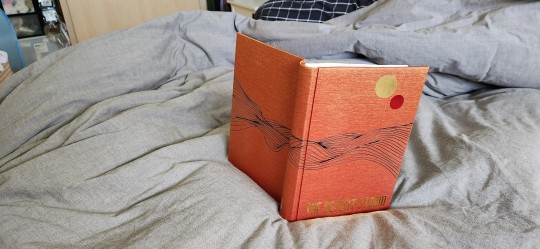
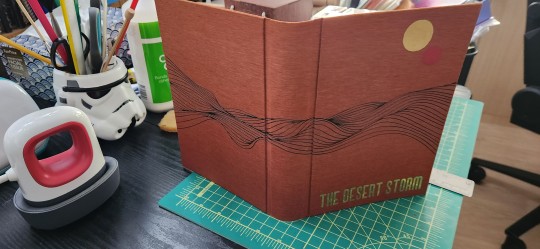
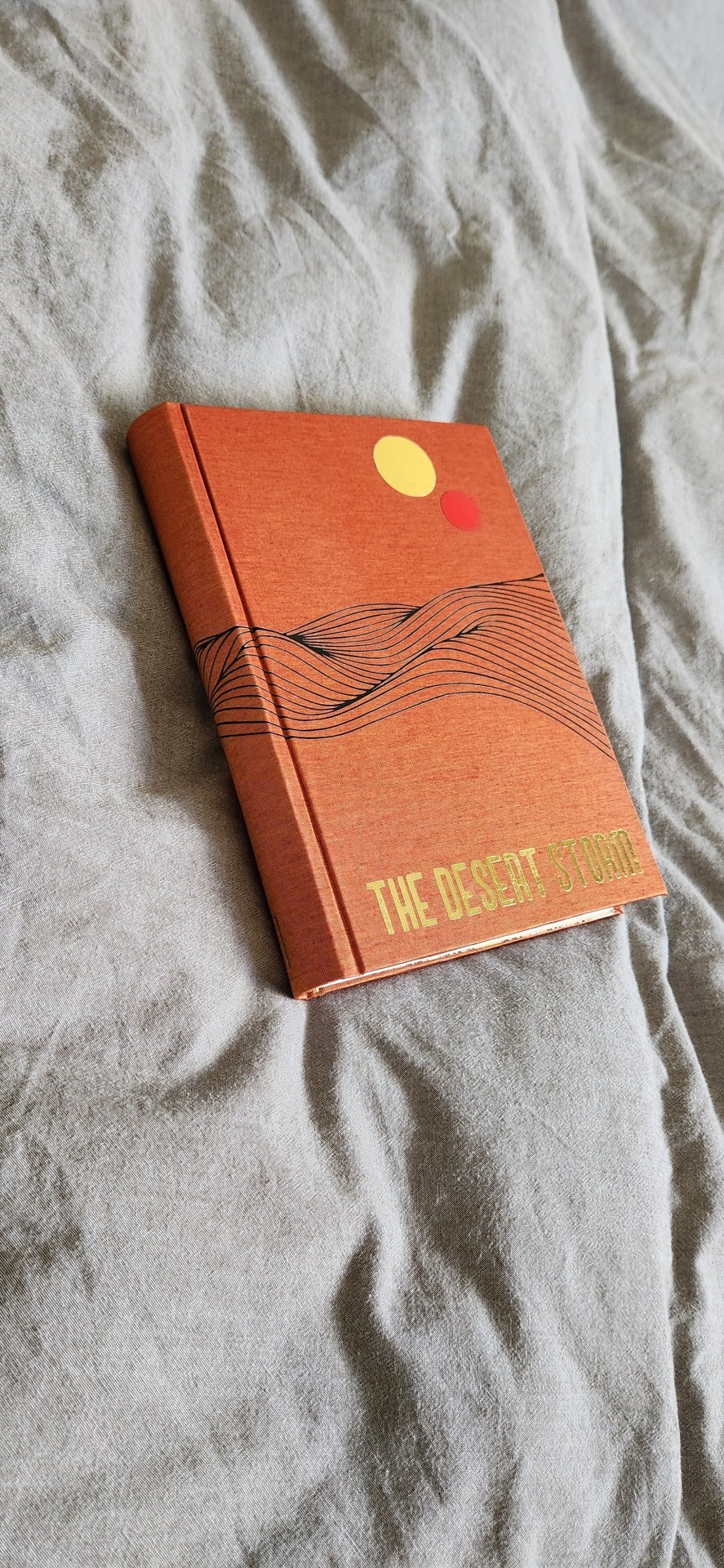
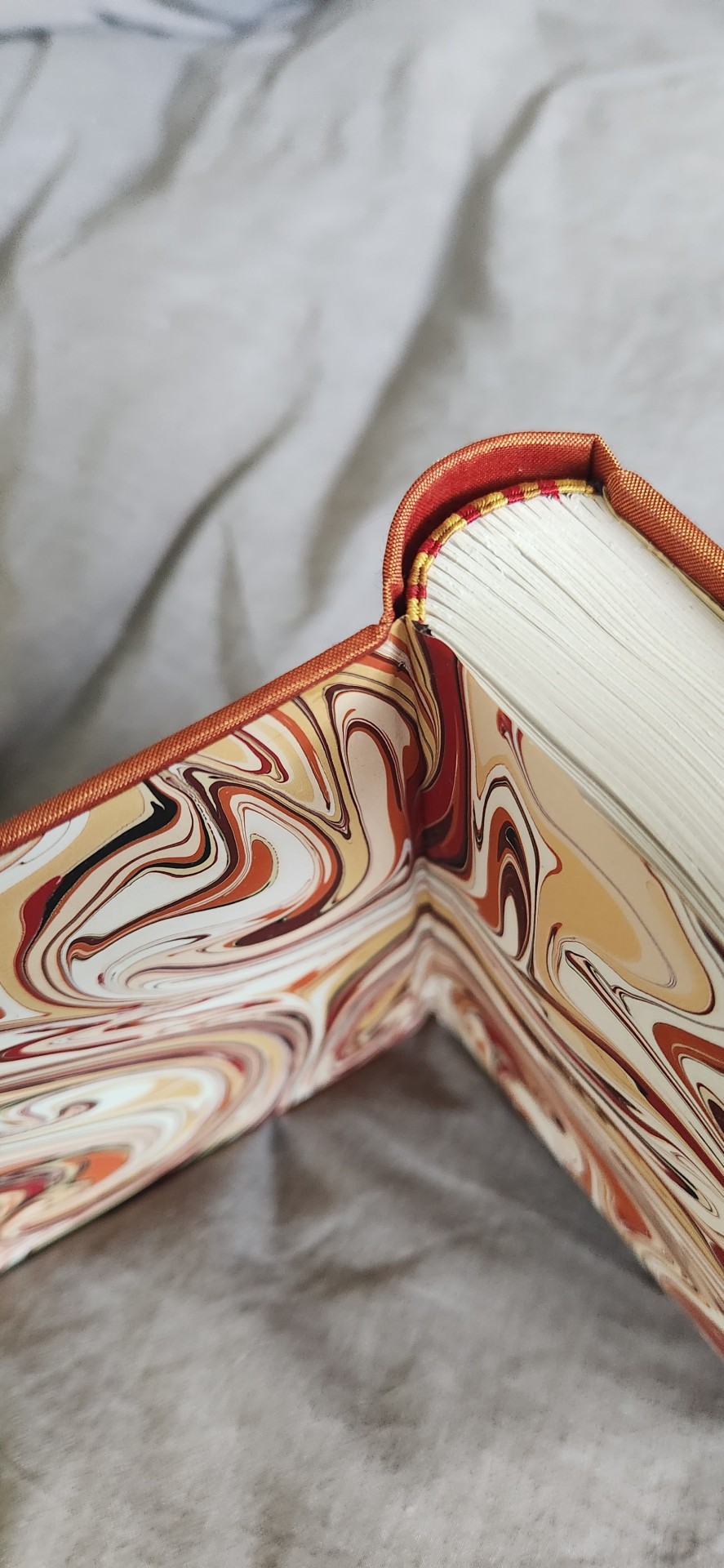
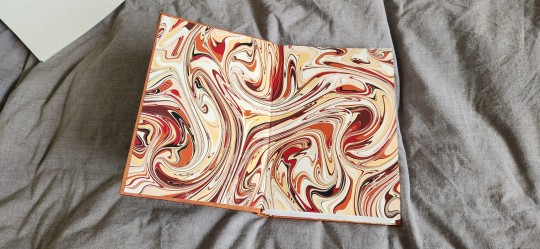
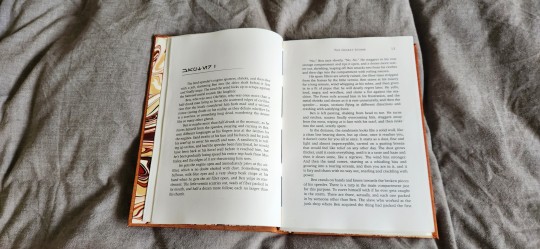
So it's been a while since i posted any books - mostly because i've been hiding my progress like a little sneak.
I just finished this bind last night of The Desert Storm by @blue-sunshine-mauve-morning, or really it's volume 1 out of like ??? 15, maybe. Please take whatever i say with a pinch of salt (I have had 0 sleep for more than 24 hours, and that tends to make me a little very sleep-deprivation drunk a.k.a. unhinged). Okay, on to thoughts! The Desert Storm was foisted onto me by @celestial-sphere-press who told me under no uncertain terms that I WOULD FUCKING LOVE THIS SHIT. Well, I did. This more than 1 million word epic about Ben Fuckin' Kenobi is pretty much god-tier fanfiction. It reads like a goddamn novel. I can never think of canon again without thinking that this good shit should be canon. I read it and then consumed half of it within a week, and I have zero regrets. @blue-sunshine-mauve-morning, i absolutely love you and love your writing. It is the best thing since sliced bread. It is better than sliced bread.
I also had the benefit of @celestial-sphere-press saying, hey would you want to use the typeset? MY GOD, i am grateful. I love this fic, i would have typeset it if it hadn't been typeset but Des did such a beautiful job that i am absolutely in awe and thankful that she and the author allowed others to use it. Look at it - it's so beautiful. I only had to think hey, i just gotta design the cover and et cetera and so the book happened.
Please also check out @celestial-sphere-press 's amazing post here and here, who is the only person i know who's started and is almost complete in fanbinding this epic, and is also making an author a copy of the entire series.
Some stats, if you will.
96215 words || 380 pages
Title font: Ghaomiec
I took some inspiration from starblight bindery's lovely desert scape as well as this amazing cover of Dune which i own. I love that the landscape emanates Dune vibes while being oh so Tattooine - just sand and heat, relentless loneliness and melancholy. This fic centres around Obi-Wan Infinite Sadness Kenobi so it needed SAD VIBES TM, which i tried to deliver in desolate landscape form.
Also thank the heavens for Renegade members, who in a masterful stroke of Group Buy Saves Money, managed to source extra-out-of-production colours of Colibri and help a fair number of us get really cool limited edition versions of bookcloth. I am now a proud owner of a lorge stash of Duo and Colibri of which i am now sitting on like a shifty dragon with a hoarding problem. Good luck getting your bookcloth now, Folio Society, ha ha (gloating)! This particular bookcloth is Colibri Copper which has been wholly stashed for The Desert Storm series. I am leaning on transitioning to Malachite for Rise and Fall when I get to it.
The front cover design was done with a stock image and converted to a PNG, which i then fiddled with and did some HTV magic with. It was remarkably easier to weed than expected. I tried something new and ironed the design on the naked bookcloth first before gluing it to the boards, which was a new challenge in making sure everything was aligned.
Endpapers are marbled endpapers (Renato Crepaldi) which I got from Hollanders, which perfectly fit the colour scheme of the bind. The only hiccup was as I was cutting, I realized the sheet was running in the opposite direction of his usual papers and half the size, and only yielded 3 A5 size endpapers and so my heart went noooooooooo. oh well. i guess i will use it for quartos.
Endbands are my favourite - silk in 3 colours in the french doublecore style (as i was binding this i did not have the mental capacity to handle the difficulty of 4 strands). the truth is i usually only can do 4 when I have higher brain function and am willing to spend 80% of my time unraveling it from getting tangled.
I also forgot to mention I had mild fuck-ups, I got glue on the front endpaper which I had to hastily remove with wet cloth, and the back square is preposterously bad but I'm ignoring it for now.
Anyway, i've actually managed to complete a few other binds which have not been mentioned here as they've all been gifts/ surprises or event books in some form. I am SO EXCITED, also because I am travelling in the latter half of July to San Diego and L.A. and I get to meet some bookbinding friends in the flesh. Renegade is fucking amazing y'all. I am ready to embrace these crazy lads who have enabled me for the last 1 year, even when i'm the solitary (1) weirdo from my country of origin in the server. Also... potentially bookbinding trip early next year??? I am enthused.
#bookbinding#fanbinding#renegade bindery#my books#star wars#clone wars#obi-wan kenobi#ben kenobi#ben naasade#infinite sadness#the desert storm#the ben naasade epic
661 notes
·
View notes
Text
People are still downplaying how many art jobs AI is going to replace, arguing that AI art looks bad or that it can’t always make exactly what you want or can’t always make an elaborate final product and this really bothers me because the vast, vast majority of art jobs in this world are just like.....a company wants a generic looking robot character for an advertising poster or a knockoff anime girl for a book cover or a soothing landscape for the background of a billboard and they don’t want to use stock art because they want it to be an image they own, even if it’s a generic or flawed one. You are surrounded every single day with artwork you probably take for granted, things on food labels and fliers and stickers and t-shirts that you might even filter out because you find them to be bland or mediocre but they still might represent money an artist was actually given. Even the ones that were purchased as part of some massive stock art pack might have been bought from an artist at one time to even be added to that stock art pack.
1K notes
·
View notes
Text
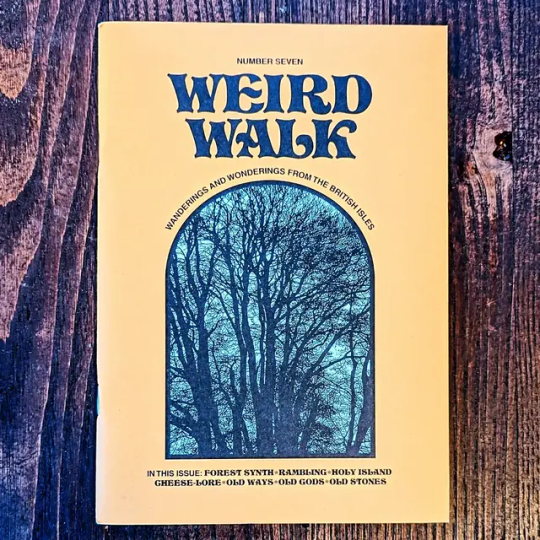
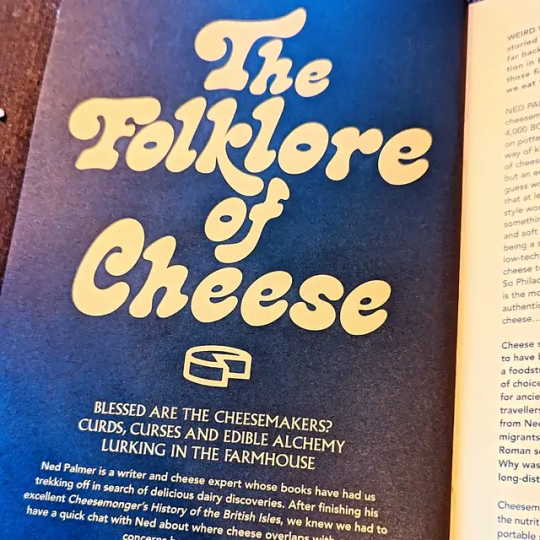

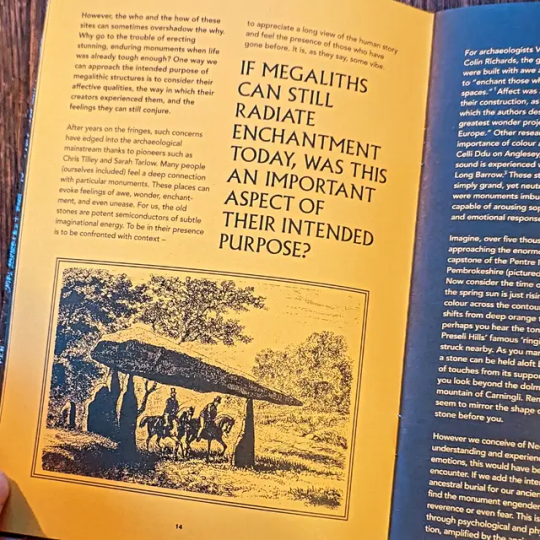
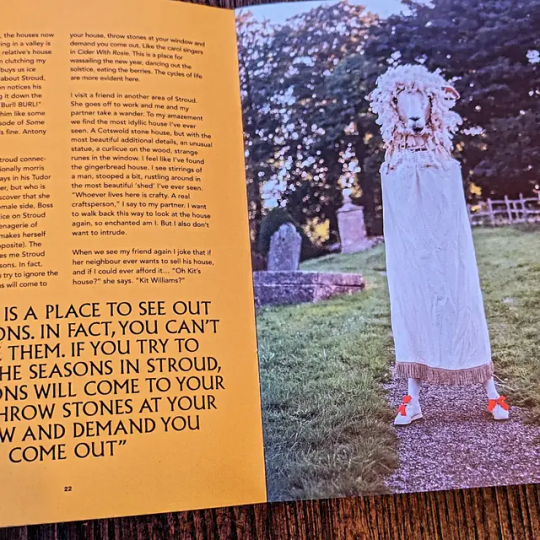
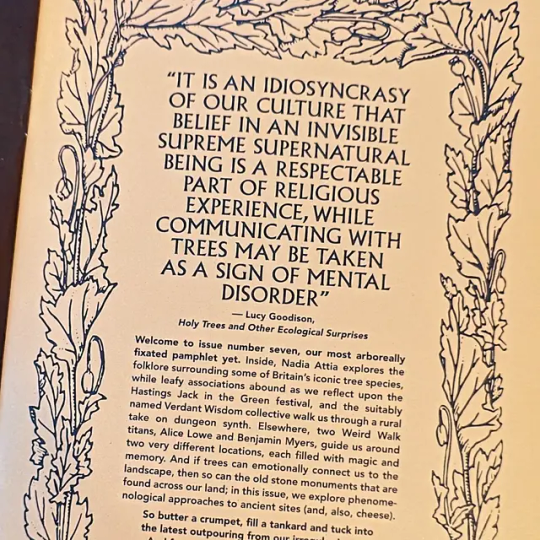
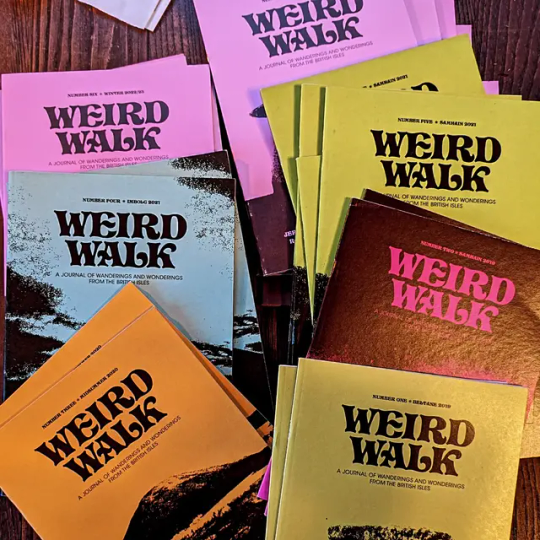
New!
Issue 7 of Weird Walk is now in stock!
Immerse yourself in the captivating world of Weird Walk Issue Seven, a 48-page A5 zine printed on high-quality, PEFC-certified recycled stock. As the sun dips low and nights lengthen, this issue serves as a potent reminder of the ever-turning cycle of nature, where decay paves the way for vibrant new life.
Delve into the ancient wisdom of trees with author Nadia Attia as she unravels the fascinating folklore surrounding iconic British species. Let your imagination wander through the verdant embrace of the forest as we delve into the history of the Hastings Jack in the Green festival and embark on a sonic exploration of rural landscapes with the Verdant Wisdom collective, whose music echoes the haunting beauty of dungeon synth.
Join intrepid explorers Alice Lowe and Benjamin Myers on separate quests through captivating locations, each brimming with magic and personal reflection. Discover the profound emotional connection between humans and the natural world, and explore the fascinating realm of phenomenology, which delves into our unique ways of experiencing ancient sites – cheese included, of course.
Weird Walk Issue Seven is further enriched by the captivating photography of Sarah White, Rachel Adams, and Freddie Miller, whose images bring the zine's themes to life.
Whether you're a nature enthusiast, a folklore aficionado, or simply seek a captivating journey through the written word and stunning visuals, Weird Walk Issue Seven offers a unique and enriching experience.
Get Weird Walk #7 at the Spiral House shop here!
We also restocked back issues!
71 notes
·
View notes
Text
icons
so i’ve noticed a few ppl following me on here still have default icons and i’m not gonna block you so dw, if you are reblogging stuff/interacting or have a description or whatever, i can see you are a real person!
however, i always see overly negative posts about this and never any actually offering any advice so i’ve decided to make a post collecting together ideas for icons, in case you guys just dont know where to start (i’ve been there)
so:
i think one of these bottle caps would make a cool icon


these pies from animal crossing are also pretty cool
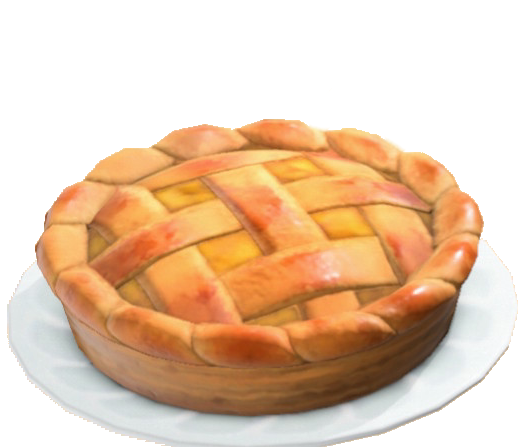
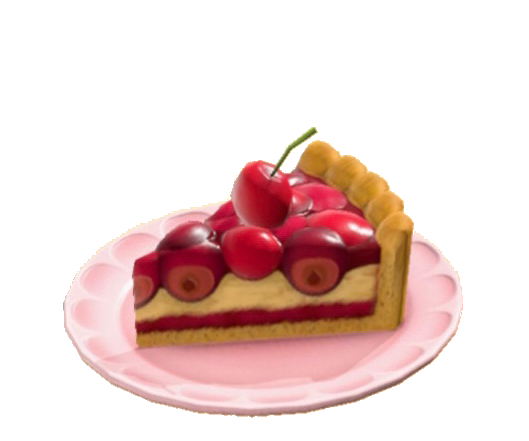
this (@oldwindowsicons) a blog full of old windows icons which is pretty cool. They have old style pixel ones and also newer ones from vista ect. And they collect ones from other software and games, you might find one from your childhood!!!



if you are particularly attatched to your default icon, this person (@anonymous-leemur ) makes edits of them! so they are still the same little guys but different (and very cool imo)



there are loads of other blogs dedicated to collecting icons for ppls use so see if you can find any others!
other options:
there is an icon tag! where ppl post icons theyve made for people to use
is there an artist you really like on here? send them a message and ask if you can use a piece of their art as a header/icon (many artists are completely fine with this, tho in the case of art you should always ask)
if they do commissions you can even commission a custom icon from them!
are you an artist? share some of your art with us! draw yourself an icon
particularly like a certain character? take a screenshot from a show/published comic and use that
take a photo of something you like or find a stock image/ clipart on search and use that. your icon could be your favourite fruit, an animal, a tool you need for your job/hobby, a landscape, any other object (picture of an orange??? a fish? a paintbrush)
pretty much, the world is your oyster. there are loads of options, the general etiquette is just that if an image isnt in the public domain already (by being in a show/published comic/stock image) you check with the artist that they are cool with you using their art. if someone is posting stuff tagged as icons, they want you to use them and you dont need to ask! some artists will ask that you credit them, you can do this by making a post saying thanks to @[artist] for the icon/header
#if you have an icon then reblog this i guess!#if ppl have options they'll be more likely not to use default icons#whereas just having a go at them before they've been here long enough to get WHY people don't like the defaults#isn't gonna do shit#it'll just make people shy
142 notes
·
View notes
Photo

Candy Witch - Special Treat
Special Treat
As the full moon cast its ethereal light across the landscape, a figure emerged from the shadows, a black silhouette barely distinguishable from the cold autumn sky. The witch stepped forward, her head held low and face shrouded beneath the vast brim of her oversized hat.
The moonlight struck her, revealing a tantalizing sight. Though her legs were modestly clad in thigh-high stockings and high-heeled boots, and her arms were draped in elegant billowy sleeves, her midsection was almost completely bare, adorned only in a small black bikini, and accented by strands of golden cord, charms, and precious jewels. Emphasized by her choice of attire, the vast exposed flesh shone with a pink glow, like the warm harvest moon through parting black clouds.
She continued forward, long violet hair accented with dancing magenta streaks, swayed around her frame like a rough sheered silken cloak. Drawing close, the bounce of her large supple breasts became more apparent. Treats of all varieties jostled and spilled to the ground from the crown of the overflowing pumpkin-shaped bucket she rocked in her hand with heedless regard.
She stopped less than a breath away, tipped her head up, and flashed an almost pleading smile, revealing amethyst and ochre eyes that sparkled with mystery.
Offering the bucket, she spoke in a seductive whisper that seemed to beg as much as command, "Place your hand inside. Whatever you grasp is the special treat that's meant for you."
---
Happy Halloween everybody!
Art Collab with Mina Cream ( @minaqueenu )
---
Support my art on Patreon https://www.patreon.com/ecchistar HD JPGs, alt versions, step by step images, PSDs, and more.
Image packs available on Gumroad: https://ecchistar.gumroad.com/
80 notes
·
View notes
Note
What’s your thoughts on the moral okayness for or don’ts on referencing real life photos or photo stock as reference in our art? There’s some that just reference and others just rough trace the poses and draw over that. Is there any code on what’s totally okay or not okay??? I’m still learning what’s okay to do and what’s not okay in situations of referencing. Is it a law or more like personal preference and opinion for each?? Sorry if this is a weird question🧚✨
of course it's okay! people have ALWAYS used photos as reference for drawing, there's nothing wrong with it. a ton of drawings I've made were done by referencing photos. almost every drawing I've posted in the past week was made by referencing photos. the drawing I've used as a header image for years is actually a paintover of a photo I like! I'll also regularly take photos of myself and then use them to draw poses that I'm having trouble with.
there is nuance to this discussion, of course; you could make an argument that it's wrong to paint over a photo of something you found online so you can like, sell it. cuz I'm sure there's ethics to essentially recreating another person's photo (which is a form of art as well, of course), especially if it's like a beautiful landscape and not just a simple pose, and then passing it off as your own completely original thing, especially for money. like idk for example, I would never use the paintover I'm using as my header in like, my business cards. cuz it's not my composition or colours or anything. but just using it as my header image feels fine cuz it's not really doing anything there, it just looks pretty and I like it (tho that being said it has been years at this point and I have been thinking it's time to change it out so perhaps this point will become irrelevant soon lol)
basically I don't really know where my personal line is, you just kinda gotta use your best judgment, cuz while I do believe it's possible to take it too far and overstep, people have been using photos as reference since the dawn of time and it's usually completely fine. unless the photographer in question specifically says please don't, of course
38 notes
·
View notes
Text
Unleashing Creativity: Top Ways to Generate Unique Fantasy Story Ideas
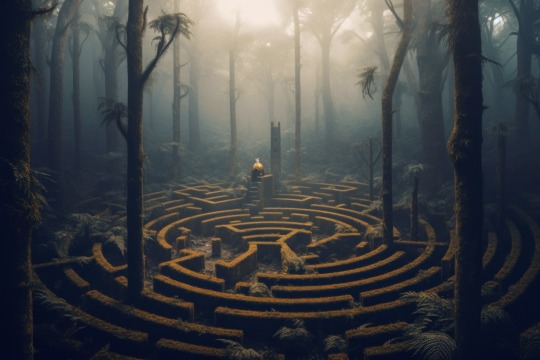
Photo: Standard License- Adobe Stock
Welcome back,
There's no denying that fantasy has been at the core of some of the most enchanting, daring, and downright unforgettable tales (for one reason or another) that have shaped the literary landscape. Who doesn't love the thrill of journeying to some new adventurous place with otherworldly creatures and epic battles between the forces of dark and light? Personally, I'm all about the dark side. Even for the most seasoned writers sparking the imagination can be difficult. Things like inspiration seem elusive as a dragon hiding in a mist-covered mountain. Today, I will cover a few ideas to find your muse. My muse sometimes hides in a dumpster...so let's find better ways to do this, shall we?
People Watching, with a Twist: Observing people in everyday situations can be a great source of inspiration. Now, add a layer of 'What If?'. What if the barista at your local coffee shop could control elements? What if the older woman feeding pigeons in the park was a retired warrior queen? This exercise allows you to create complex characters with intriguing backstories, ripe for the world of fantasy.
Travel Through Time: History is brimming with periods that, with a little twist, can become fantastic settings for your story. Victorian England's social hierarchies, the Renaissance's scientific innovations, and the fierce battles of Feudal Japan offer fertile ground for fantastical tales. Weave in elements of magic or mythical creatures, and you have an intoxicating cocktail of historical fact and enticing fantasy.
Bioinspiration – Fantasize with Flora and Fauna: The natural world is a veritable treasure trove of inspiration. Let's call this approach 'bioinspiration.' Start by exploring Earth's biodiversity's peculiar traits, behaviors, and survival mechanisms. Why not envision a species that communicates like whales but hunts like a pack of wolves? Or perhaps a plant that blooms under the moonlight and has the power to manipulate time? The possibilities are endless when you fuse the wonder of our world with a dash of fantasy.
Take a Hike (Literally!): When was the last time you truly engaged with the wilderness, the mountains, or the sea? Natural landscapes are rife with potential for fantasy storytelling. As you walk through a dense forest, consider the creatures that might inhabit such a place in a fantasy realm. That murmuring stream could be a water nymph's dwelling, and the wind howling through the canyon might be a dragon's call. Try to visualize your surroundings through the lens of fantasy — you may be surprised at what your imagination conjures up!
Harness the Power of Music: Like music, few things can stir the soul and spark the imagination. A piece of music can evoke many emotions and images depending on its rhythm, melody, and harmony. Try listening to music without lyrics (like classical, orchestral, or ambient music) and let your mind wander. Picture the scenes that the music evokes. Is that tranquil harp melody the song of a peaceful elven village? Does the tumultuous symphony represent the climax of an epic battle? Use these mental images as a springboard for your fantasy narrative.
So there it is, everyone. Five unique ways to draw up some inspiration. Go find your muse!! Probably shouldn't have said mine hides in a dumpster. I'm all about being superstitious, so I'm sure she'll never speak to me again.
Happy Writing,
Indigo Everly
P.S. Need more? Check out this post!
#WritingCommunity#Writeblr#WritersOfTumblr#CreativeWriting#WritingInspiration#WIPJoy (Work-In-Progress Joy)#WritersLife#WritingTips#ScriptScribbles#ProseAndPurpose#WriteItOut#StoryStarters#CharacterCreation#PlotTwists#WritingPrompts#WordCrafting#NaNoWriMo (National Novel Writing Month)#StoryScribes#PoeticProse#FanFictionFridays#FantasyStoryMagic#WritingWithDragons#WorldBuildingWonders#MythicMuses#BioInspiredTales#TimeTravelNarratives#DreamscapeEpics#ArtisticStorytelling#NatureImagined#MusicFueledFantasy
80 notes
·
View notes
Text
youtube
A Derek Jarman film with music by Throbbing Gristle
Derek Jarman used some of his 70s home movie footage to produce this wonderful piece of exploitational avantgarde cinema. Actually the original material has been slowed down to a speed of 3-6 frames, then Jarman added colour effects and the pulsating, menacing score by Industrial supergroup Throbbing Gristle The result is a piece of art not to dissimilar to Jarman’s painting work in using found footage as elements of memory and mind that resemble ideas reflected in the Cabala and in C.G. Jung`s writings about an archetypical past that is hidden in everyone of us. The first, In the Shadow of the Sun (1974-80), was originally put together by Jarman himself in 1974 from re-shot Super-8 material including footage from The Art of Mirrors and Journey to Avebury, amongst several others. The film was eventually blown-up to 35mm and premiered at the 1981 Berlin Film Festival. The focus on ritual, mysticism and obscure alchemical symbolism links it with the work of Anger. However, Jarman’s preference for the work of Carl Jung and the “white” magician John Dee, is quite distinct from Anger’s invocations of the “black” magician Alistair Crowley. – Jon Behrens
Extending the recent pagan theme, Ubuweb posts Derek Jarman’s determinedly occult and oneiric film, In the Shadow of the Sun (1980), notable for its soundtrack by Throbbing Gristle. This was the longest of Jarman’s films derived from Super-8 which he made throughout the 1970s between work as a production designer and his feature films. He never saw the low resolution, grain and scratches of Super-8 as a deficiency; on the contrary, for a painter it was a means to achieve with film stock some of the texture of painting. Michael O’Pray described the process and intent behind the film in Afterimage 12 (1985):
In 1973, Jarman shot the central sequences for his first lengthy film, and most ambitious to date, In the Shadow of the Sun, which in fact was not shown publicly until 1980, at the Berlin Film Festival. In the film he incorporated two early films, A Journey to Avebury a romantic landscape film, and The Magician (a.k.a. Tarot). The final sequences were shot on Fire Island in the following year. Fire Island survives as a separate film. In this period, Jarman had begun to express a mythology which he felt underpinned the film. He writes in Dancing Ledge of discovering “the key to the imagery that I had created quite unconsciously in the preceding months”, namely Jung’s Alchemical Studies and Seven Sermons to the Dead. He also states that these books “gave me the confidence to allow my dream-images to drift and collide at random”. The themes and ideas found in Jubilee, The Angelic Conversation, The Tempest and to some extent in Imagining October are powerfully distilled in In the Shadow of the Sun. Jarman’s obsession with the sun, fire and gold (which spilled over in the paintings he exhibited at the ICA in 1984) and an ancient mythology and poetics are compressed in In the Shadow of the Sun with its rich superimposition and painterly textures achieved through the degeneration “caused by the refilming of multiple images”. Jarman describes some of the ideas behind In the Shadow of the Sun:
“This is the way the Super-8s are structured from writing: the buried word-signs emphasize the fact that they convey a language. There is the image and the word, and the image of the word. The ‘poetry of fire’ relies on a treatment of word and object as equivalent: both are signs; both are luminous and opaque. The pleasure of Super-8 is the pleasure of seeing language put through the magic lantern.” Dancing Ledge p.129
John Coulthart
#Youtube#In the Shadow of the Sun (1981)#Derek Jarman#Throbbing Gristle#compilation#8mm short films#soundtrack#experimental#sound art#music#Super 8 films#film
24 notes
·
View notes